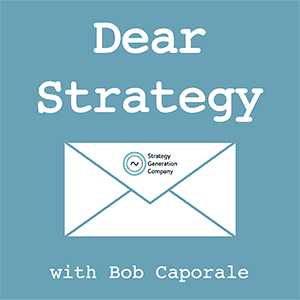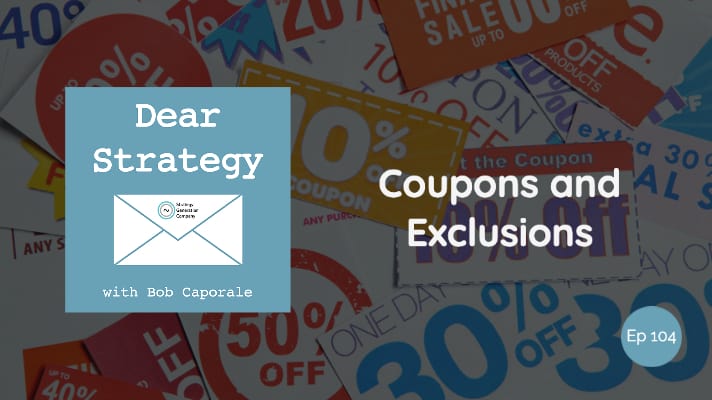On this episode of Dear Strategy, we analyze a story about trying to use a coupon at a retail store, only to find out that certain brands have been excluded. What is this practice all about and why does it seem to be trending toward becoming the new norm?
So the story goes like this:
There was this jacket that I really liked, and my wife wanted to get it for me for my birthday. A few weeks before my birthday, a 20% coupon arrived in the mail for a store that had the jacket in stock. After 25+ years of marriage, bargains win out over surprises, so off we went to buy the jacket as an early gift. Cutting right to the punchline, she got to the register (with jacket in hand) only to learn that the coupon didn’t apply to this specific brand. Cue the shock, anger, and half-whispered profanities as she storms out of the store. And the ride home was no better – especially when I tried to explain to her the technical reasoning behind all of this. She didn’t seem to appreciate it at the time, so maybe you will…
When you go into a retail store, what you’re actually experiencing is a supplier relationship between the manufacturers of products and the retail store itself. That is, manufacturers sell their products to retailers, and then those retailers resell those products to consumers. Depending on the size of the manufacturers and retailers involved, there could also be wholesalers and/or distributors in the middle of that chain. However, for the purpose of simplicity, let’s just talk about the basic buy-sell relationship that ultimately exists between manufacturers and retailers.
When one party buys an item from another party, the buying party generally has the right to resell that item at whatever price it chooses. In a retail environment, this translates into manufacturers having no real control over the prices that retailers set for their products. Because the retailers are buying in bulk and also providing a valuable service to the manufacturers, they are generally able to buy products at prices that are far below what those manufacturers want their consumers to pay. But, technically, there is nothing to prevent a retailer from turning around and selling those products to consumers at whatever prices they choose. So, to dissuade retailers from passing along their heavily discounted prices into the marketplace, manufacturers will typically provide some type of guidance to their retailers to help maintain some level of influence over their ultimate market pricing.
Now, before we go on, you might ask yourself why manufacturers would care about such things. I mean, they already made their money by selling their products to the retailers, right? So why should it matter what prices the retailers sell those products for? Well, there are actually many reasons why manufacturers would care, but some of the top candidates include:
- Manufacturers want their products to be priced in the marketplace in accordance with the position that they are trying to establish with their consumers. In other words, manufacturers of “premium” products want their end-user pricing to support that position.
- Manufacturers want their retailers to maintain healthy margins – mainly because if the retailers aren’t making any money, then the manufacturers will ultimately be forced to sell to those retailers at lower prices.
- Manufacturers want, as much as possible, to maintain consistent pricing across all of their channels – particularly if they are also selling their products directly to consumers as well. Now, this one gets tricky because, as I stated above, retailers generally get to sell products at whatever prices they choose. However, manufacturers can provide guidance to their retailers, which is exactly what they try to do…
So, there are two main types of guidance that manufacturers typically provide to their retailers: The first is referred to as a Manufacturer’s Suggested Retail Price (MSRP), and the second is referred to as a Minimum Advertised Price (MAP).
“Manufacturers want their products to be priced in the marketplace in accordance with the position that they are trying to establish with their consumers.”
MSRP is exactly what the name implies. Manufacturers sell their products to retailers at heavily discounted prices, and then they provide suggested prices that retailers can use when reselling those products. This allows retailers to freely compete on their own terms, while still allowing manufacturers to provide some level of guidance regarding the prices they would ultimately like to see in the marketplace.
MAP takes MSRP one step further by providing guidance as to the minimum price that a retailer can advertise a manufacturer’s products. Because this usually takes the form of a policy rather than a suggestion, any retailer who does not abide by the manufacturer’s MAP could risk losing access to that manufacturer’s products. There are other variations of this type of pricing policy, including versions that cover the actual resale price versus just the advertised price. But the idea is basically the same – manufacturers implement a pricing policy across all of their retailers, and those retailers decide if they wish to follow it or not. If they follow it, they get to keep selling products from that manufacturer. And if they don’t follow it, then they risk losing access to a valuable brand.
And that brings us to all of those annoying little exclusions that appear on the backs of most coupons. Directly or indirectly, these usually exist as a result of one or more of these manufacturer pricing policies. Now, this is admittedly a bit of an oversimplification because every pricing policy is somewhat unique, with some specifically addressing coupons, and others remaining a bit more vague on the subject. But, whatever the vehicle, it’s safe to say that most coupon exclusions (perhaps not all, but most) are driven by the manufacturers rather than by the retailers. And it’s also safe to say that manufacturers can only pull this off after they’ve built up some amount of consumer pull-through in the marketplace. In other words, the product or brand has to be one that the retailer doesn’t want to lose; which is why you usually only see the most desirable brands being excluded from most coupons.
So that’s what’s going on. But the real question is – is it a good strategy? Well, on the manufacturer’s side of the equation, they get to maintain a certain advertised price in the marketplace. This allows them to maintain higher margins, which can then be reinvested into creating better products. So, yes, I would say, on the whole, this is a good strategy for manufacturers.
On the retailer side of things, they also get to maintain higher margins, and they get to put all those annoying little exclusions into the fine print that nobody reads. So the coupons still draw people into the store, and, once there, I’m sure that most shoppers will still try to find something they can use those coupons on even after they learn about the exclusions. Is it a bit on the sneaky side? Perhaps. But it does work, so I can’t say that it’s a bad strategy. It’s not a strategy that I particularly like – but it is a strategy that seems to get results.
So what was the conclusion of my little story? After my wife cooled down a bit and realized that she couldn’t buy that jacket at a discounted price anywhere else, she ended up going back to that same store and purchasing the jacket at full price. And she did so with the same coupon in hand, which she happily used for other items that were not excluded. So it looks like everyone won. I got my jacket, the retailer made their full margins, and the manufacturer maintained their position in the marketplace as a more premium brand. And, as an added bonus, my wife now reads the backs of all of her coupons. And, although she’s still not particularly happy about all those exclusions, she at least understands that they do, indeed, exist. And she also understands why.
Well… at least you do – because I’m still not sure she’s ready to hear my full explanation!
Listen to the podcast episode
Dear Strategy: Episode 104

Are you interested in strategy workshops for your product, marketing, or business managers? If so, please be sure to visit Strategy Generation Company by clicking the link below:
 Bob Caporale is the founder of Strategy Generation Company, the author of Creative Strategy Generation and the host of the Dear Strategy podcast. You can learn more about his work by visiting bobcaporale.com.
Bob Caporale is the founder of Strategy Generation Company, the author of Creative Strategy Generation and the host of the Dear Strategy podcast. You can learn more about his work by visiting bobcaporale.com.







